#Death Attribute Magician
Text
[Commentary] Revisiting Problematic: Jobless Reincarnation Vs. The Death Mage

Source: https://www.ebay.com/itm/184348670012
DISCLAIMER: This post contains content that we at The Anime View do not think is suitable for everyone. The genre of the work being reviewed is ecchi. Possible triggers or subjects could include sexual assault and pedophilia. There are no images of such, but these topics are discussed. By clicking “Keep Reading,” you understand that you may encounter such content. Viewer/reader discretion is advised.
By: Peggy Sue Wood | @pswediting
If you know me, you know that I hate Mushoku Tensei: Jobless Reincarnation. In a previous post, I claimed that it was a hentai series that bordered on pedophilia and labeled my distaste for conversations that try to defend the work for its art and storytelling while ignoring how that art and storytelling create the problematic features I just described. In response, some argued that the series was merely ecchi and insisted again on its great storytelling. I must admit that I was wrong about the classification. It is not officially considered a hentai but an ecchi. However, that is not much better as it still sexualizes young, underdeveloped children. #gross
I stand by my belief that the story of Jobless Reincarnation is not so great as to overlook the parts that sexualize children. The art also emphasizes this focus, and it is not just fan service. I am alarmed that some members of the community confuse the two.
I have tried to find a comparable title that I think does a better job of being overt yet suggestive, and I think I have with The Death Mage Who Doesn’t Want a Fourth Time. (Let me give a quick thank you to one of my friend’s who recommended The Death Mage, which I think fits well into this discussion–I know you don’t want to be named/tagged, but I do appreciate you reading the different titles and providing a reasonable selection for my more conservative sensibilities. 🙇🏻♀️)
The Death Mage follows the journey of Vandalieu, a half-vampire and half-dark elf being with a unique skill of death magic. Essentailly, he’s a necromancer and a very powerful one at that. He’s already been killed for it before, and in his newest life he’s found more suffering as a result of the skill and his own bloodline. Compared to Rudeus from Jobless Reincarnation, Vandalieu is more mature and has a clear sense of purpose and a series of specific challenges that stem an external source. The story deals with themes such as finding your place, death, loneliness, and betrayal, with more serious and darker approach than Jobless Reincarnation‘s exploration of similar ideas. There are many obstacles to Vandalieu’s path, including his former classmates that have also reincarnated with him in these new worlds, and the god of this story, who is managing these cycles seems intent on Vandalieu’s suffering.
Image-wise, The Death Mage certainly depicts more risky costuming. Most of the adult women having a large chest and revealing clothes, even nudity at times, but the coverage is enough to meet today’s standards of a bathing suit or lingerie. Even moments of nudity are covered by speech bubbles/text or are made unsexualized by the context. For example, breastfeeding is depicted in both works, but where Rudeus makes a show of sexualizing his mother in this moment and continuing to do so as the story progresses, Vandalieu sees it as an embarrassing and strange experience.
I think that is what really sets the two apart. In The Death Mage, scenes are suggestive, but the tone makes clear distinctions about when the suggestiveness of the attire for characters is the focus and when readers should be paying attention to the story. Compared to Jobless Reincarnation, the overt sexualizing is relatively mild and infrequent and on adult character. I have seen some readers claim it to be a series alright for mature, general audiences while not being appropriate for younger readers or those who are sensitive to violence and mature themes and I can see their argument (I disagree, but I see it). Of course, I have seen the same argument for Jobless Reincarnation, but I strongly disagree on that front and do not understand it still. To be clear, both series hold strongly suggestive materials, stong enough to border on pornographic–but one chooses adults as a focus, and another chooses a mix of children and adults. I don’t think I have to explain further why that is a noticeable and important difference.
There are other notable differences too, but also similarities, as I’ve mentioned above. Both series depict a deep and intricate magic system, which plays an important role in the story’s world-building, and both are in the ecchi genre. They are clearly, different stories with different leads, but have similar themes. It is these elements that I think makes them comparable, in addition to how they frame the sexualization of female characters. One series more acceptable than the other because the content draws a line on what is okay and what isn’t, and I think that the larger fan community would do well to recognize the differences and how some perpetrate the “merits” of these stories while ignore negative elements.
On a final note: Would I recommend either of these works? Absolutely not. I don’t like the genre or their individual stories enough to promote them as recommended reads. There are better reads/watches out there. I decided upon making this post because Jobless Reincarnation got another adaptation this past July that is going on right now and I see way too many people continuing to ignore its problematic traits in praising its “story” when there are better works out there. I believe, as I have before, that it one of the worst of the worst series to gain the kind of general following that it has and that it highlights a dark undertone to the anime fandom community. With that, I will now excuse myself to try to find a new way to forget this series entirely and clean myself from the gross feeling I got reviewing this for the post. 🖐️🎤 &✌️ 📤
#anaylsis#commentary#death attribute magician#isekai ittara honki dasu#jobless reincarnation#mushoku tensei#mushoku tensei: isekai ittara honki dasu#mushoku tensei: jobless reincarnation#the death mage#the death mage who doesn't want a fourth time#yondome wa iyana shi zokusei majutsushi
1 note
·
View note
Text
I know I've definitely seen posts abt this before, but I can't get over how much the 'Jordie' in Kaz's head is just... not Jordie. Like obviously it's not, bc he's dead, but it's also not even accurate to Kaz's memory of him.
Like these are the sorts of things that are attributed to 'the voice of' Jordie:
Jordie had come for his vengeance at last. It's time to pay your debts, Kaz. You never get something for nothing.
But he could hear Jordie laughing. No, little brother. No one is stronger. You've cheated death too many times. Greed may do your bidding, but death serves no man.
While Jordie was no stranger to grandstanding statements, and one might argue Kaz actually picked that habit up from him ('The city is winning so far, but you'll see who wins in the end' for example), these aren't the sorts of things he'd have said to his kid brother??? Yes, he could be arrogant, and he's snappy with / acts superior to Kaz a few times, but as far as we see, Jordie is mostly very good with Kaz; he has a remarkable tolerance for/patience with him, especially for a newly orphaned thirteen year old. Kaz admittedly comes across as a quiet kid and is pretty compliant; he rarely talks to anyone except Jordie and Saskia, he seems to just watch for most of their interactions with 'Hertzoon', he largely does as he's told and doesn't wander off, but he's still like... nine, and wants to do stuff like see the magicians and make all the dogs walk at once, and sulks when Jordie stops him from doing stuff and makes him stay inside. We also see Jordie pretty frequently lying to Kaz to try and make him feel better. But this mental-Jordie is not a comforting presence. The start of SOC is literally set up to make you think Jordie is someone that Kaz has swindled or betrayed, that he fears will come back for vengeance, so it's a big 'oh wait wtf' moment when you realise that he's not a rival gang member or anything, he's just his brother, and it wasn't his fault. But you wouldn't know it! Kaz wants 'Jordie's' voice silenced 'forever' and seems afraid of it, almost— at least, it turns up in vulnerable moments. He thinks that 'paying his debt' (i.e. taking out Rollins) will get rid of it. (Sorry hon. It won't.) Kaz thinks at one point that he still sees Jordie as "infallible" and looks at him through the eyes of the child he'd been, but in other scenes he's glove-puppeting 'his brother' to punish himself. I guess he still sees Jordie, even in death, as the ultimate authority figure, and to cope with guilt/stress/grief he imagines that this is something he's being compelled or commanded to do, and that when he does it he'll have redeemed himself, when really it's just desperate flailing to get the closure he couldn't have. I'm sure he knows goddamn well that this isn't actually what Jordie wanted for him ('You'll go to school') and that's why the mental 'Jordie' is really off, because Kaz knows its not really the will of his brother— it's just him. It talks like him! He doesn't even try to imitate the real Jordie! It's just Kaz, alone— but he's never really been able to come to terms with that.
#kaz voice I don't believe in anything. except the mental mystery cult I started for my dead brother where I'm the only member#six of crows#kaz brekker#jordie rietveld#my post#soc meta
250 notes
·
View notes
Text

Huli jing 狐狸精
Fox Spirit
In ancient China, the most widely known of the seductive spirits were the "Fox Spirits" who were believed to live high in the misty mountains. The Fox Spirits could take on a human form by transforming themselves through the aid of human bones (especially the skull). Foxes are associated with Yin and the Earth Element. They are associated with deceit, trickery, slyness, cunning, and craftiness. Documents dating back to the dawn of China's civilization identify the fox as a demonic creature, upon whose back spirit entities often ride. According to the famous Daoist scholar Ji Yun:
"Humans and things are different species, and foxes lie in-between humans and things; darkness and light take different paths, and foxes lie in-between darkness and light; gods and demons follow different ways; and foxes lie in-between gods and demons."
Both anthropologists and historians have emphasized the significance of the betwixt and between for the study of culture. Mary Douglas, for example, gives special importance to boundary-crossing animals and spirits in assuring social and moral order. She argues that in a given society, what is perceived to be ambiguous and marginal tends to be regarded as ritually unclean, hence defiling established principles. The marginality of such beings discharges both danger and power to the dominant patterns of the existing social structure. Victor Turner further elaborates the symbolism of marginality and ritual. He contends that rituals are organized around certain key symbols that simultaneously encompass many different meanings. Only by relating the ritual symbols to social experience can one decipher their multivocality. Turner also develops the concept of liminality:
"Liminal entities are neither here nor there; they are betwixt and between the positions assigned and arrayed by law, custom, convention, and ceremonial. As such, their ambiguous and indeterminate attributes are expressed by a rich variety of symbols in the many societies that ritualize social and cultural transitions. Thus, liminality is frequently likened to death, to being in the womb, to invisibility, to darkness, to bisexuality, to the wilderness, and to an eclipse of the sun or moon."
In other words, the betwixt and between represents a liminal phase, an ambiguous and paradoxical stage of being neither this nor that—or being both. It is a ritual stage that allows people to change from one state to another, and thereby to reorder the world and to gain new power to deal with life. Liminal situations and roles tend to be conceived as “dangerous, inauspicious, or polluting to persons, objects, events, and relationships that have not been incorporated into the liminal context.” In popular culture and folk literature, they are likened to marginal groups, such as shamans, mediums, magicians, and jesters, who usually come from the bottom of society yet are endowed with the ritual power of the weak to reverse established social structures and express cultural oppositions.
An encounter with a Fox Spirit could either be considered positive or deadly, depending on the type of interaction, and temperament of the spirit entity. For example, the victim could end up either having intercourse with a demonic vampire, or having a romantic interlude that ended up in marriage. Because Fox Spirits could either appear as men or women, and transform themselves into the images of individuals who are sometimes young or old, each interaction was uncertain. Historically, Fox Spirits could sometimes act like malevolent ghosts, haunting and bewitching people, causing sickness and even death. Other times, they could assume the positive role of a benevolent loving spouse, or act live a compassionate Ancestral Spirit, granting an individual health, wealth, and fame. Therefore, in relationship to humans, an interaction with a Fox Spirit could either be benevolent or vindictive, according to the treatment that the fox received. For example, one of the positive attributes associated with magical Fox Spirits, is that they retain the knowledge of hidden or buried treasure. They could either use these riches for their own personal gain, or they could reveal these treasures to their human friends.
The Fox Spirit does not have the power to change its tail. This often leads to its discovery. An ancient saying states:
"Talk of demons and they will appear; talk of a Fox Spirit and his tail will be seen."
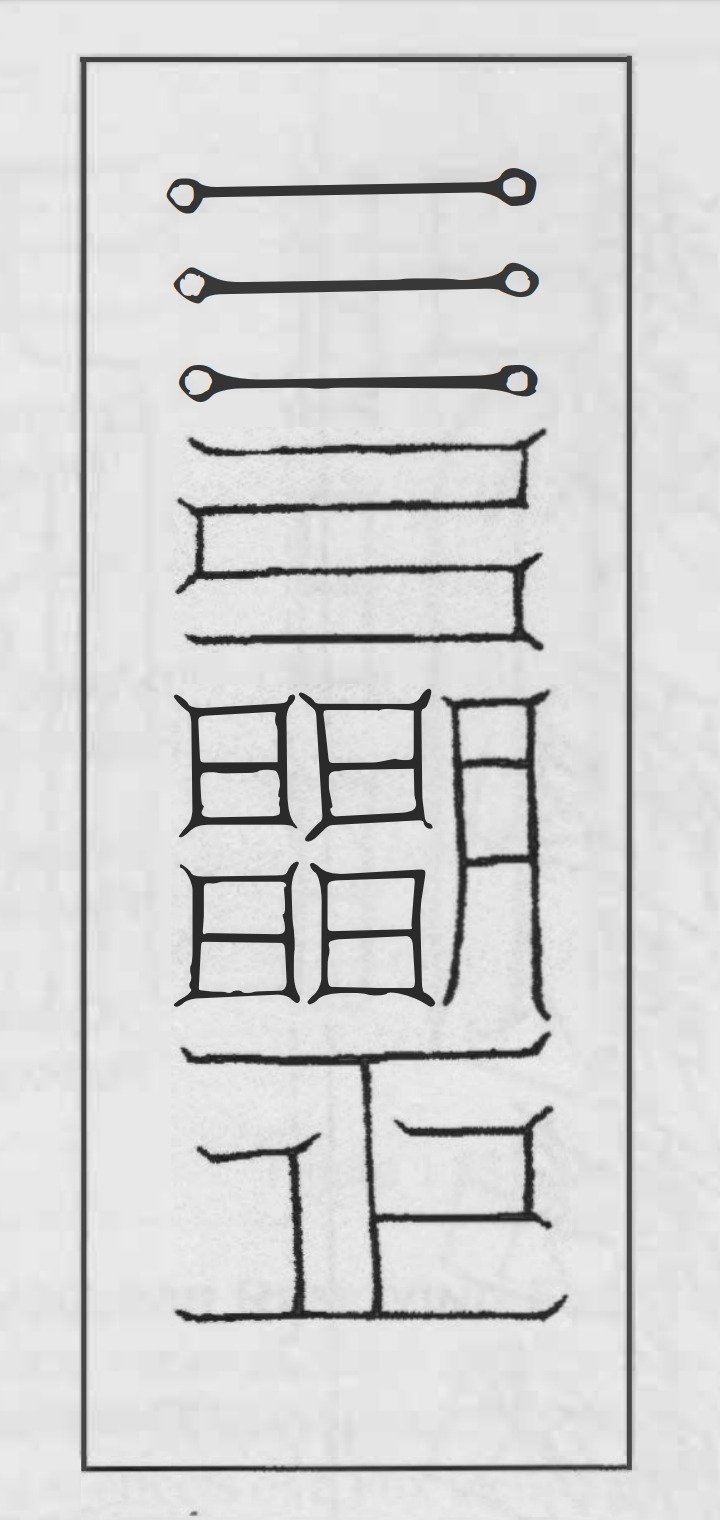
Magic Talisman used for Summoning Fox Spirits
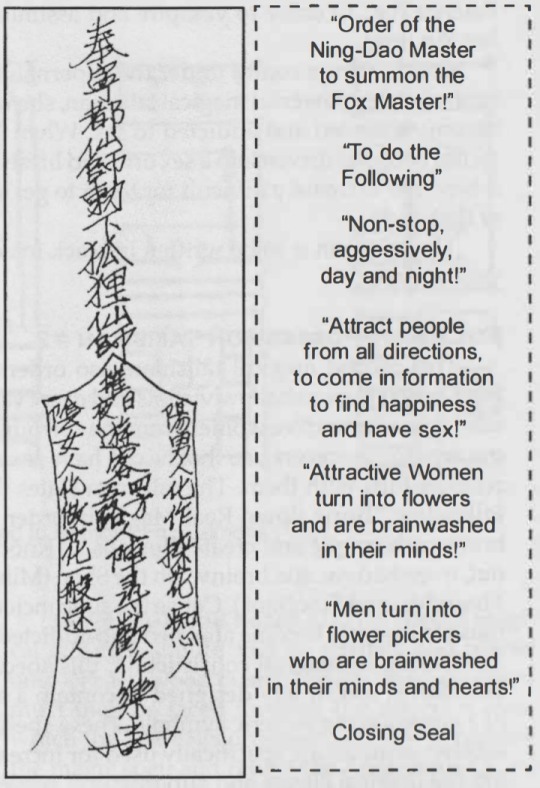
Magic Talisman used for
Summoning Fox Spirits
#taoism#taoist#daoism#daoist#magick#magic#occultism#occult#yao guai#kuei#japonese yokai#yin yang#yin and yang#satan#satanism#satanist#satanic#demon#demonic#huli jing#kitsune#mysticism#spirituality#esoteric#chinese culture#chinese folklore#left hand path
87 notes
·
View notes
Photo
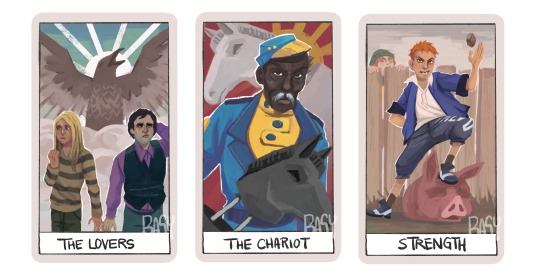
Part 3!
And oh boy, this one definitely needs explanation, so see you down in the ramblings.
(1) THE FOOL / THE MAGICIAN / THE HIGH PRIESTESS |
(2) THE EMPRESS / THE EMPEROR / THE HIEROPHANT |
(3) THE LOVERS / THE CHARIOT / STRENGTH |
(4) THE HERMIT / WHEEL OF FORTUNE / JUSTICE |
(5) THE HANGED MAND | DEATH | TEMPERANCE |
(6) THE DEVIL / THE TOWER / THE STAR |
(7) THE MOON / THE SUN / JUDGMENT / THE WORLD
I gotta be real, this is my least favorite set so far. I was very unsure about the characters I chose for these and it also shows in the compositions. I might redo them at some point but I want to finish the major arcana as a whole first, before I lose myself in revisions. Maybe I shouldn’t be too harsh on myself anyway, because this is just a fun project but, ah, perfectionism.
Anyway, citations from here, as always.
THE LOVERS - Actually means that the protag feels sexual urge or need for relationship. Harry basically flirts with everyone and is still hung up on his broken relationship, that he doesn’t even remember, so the meaning here is pretty warped. So I just chose some lover figures. But who to choose? Klaasje and Lely? Well their relationship gets known pretty late, and didn’t end very nicely. Also I do not know how Lely looks like as not-a-corpse so-- Klaasje and Ruby? Seemed to me more like a fling, and didn’t interest Harry much except for some lecherous line he dropped. So I chose Sylvie and Garte, because Harry actively gets involved in their business. He can help them get together or ultimately break their relationship before it could ever bloom (Shoutout to the cock carousel) so I chose them because Harry is the most involved here.
THE CHARIOT - I’m just gonna quote for a bit “The Chariot represents the vigorous ego that is the Fool's crowning achievement so far. (...) we see a proud, commanding figure riding victoriously through his world. He is in visible control of himself and all he surveys.” Not many people with horses around there in Martinaise, only people driving cars. None of the lorry drivers fir the description for me though. The chariot is also described as commandeering and rigid, and René fit the description for me the most. He is definitely a proud person, commandeering and strict, and also surveying the world around him from his booth up at the harbour. Otherwise, yeah I got nothing. This one was just hard lol
STRENGTH - “[The fool] is pressed to develop his courage and resolve and find the heart to keep going despite setbacks.” was a line that made me very desperately want to choose Kim here, but I had other plans for him already. Strength is part of the Virtues trio, and spoiler spoiler, Kim will get his place as one of the three Virtues, but this one goes to Cuno, because I feel he is also very influential on Harry. Another quote for the card is “The Fool also discovers the quiet attributes of patience and tolerance.“ which I think fits Cuno quiet well. Because boy do you need a lot of patience and tolerance with him to make him trust and help you. But ultimately he is also there in the end if you need him (and Kim is unfortunately not present) All in all, what could make you want to get your shit together more than escaping the mocking words of a potty-mouthed kid. Horrifying lol
I tried really hard okay. I’m sure there are other interpretations but that’s the best I could come up with.Meanwhile I also bought an art book of a really pretty tarot set I saw at the last convention I was at, and there were so many lovely compositions that almost made me question what I am doing here. But again, I’m doing these for fun [*self prep talk*]. Still, take a look at this magnificient tarot deck (Instagram Link) I’m so sad they were sold out, but at least I got the art book.
Uhhh anyway enjoy. Next set will be better I promise. I like the upcoming one a lot : )
250 notes
·
View notes
Note
WE NEED MORE ALBERT SHAW X FEM READER FICS ‼️ ethan hawke just hits diff
YES! See my Grabber x Reader fic Masterlist below this text (: I have attributed a few to the fandom by popular demand. And there's a Reader having her Period Request Fill coming up right after Halloween. So keep an eye on my Tumblr if this takes your fancy. There are more prompts pending.
I also write for other Ethan characters. I have quite a few fills for Moon Knight's Arthur Harrow, and my very first Ernst Toller fill for the Halloween prompts is online. Send me more, I would love it.
MASTERLIST BLACK PHONE
The Black Phone (2022)
Albert Shaw / The Grabber:
Stories:
*~* The Chance to make a Change (Grabber x Reader) When you end up in front of the Grabber’s house, you decide to take matters into your own hands and stop Albert Shaw from kidnapping and murdering these innocent boys like he does in the movie. You have good intentions. But will you succeed? (Rating Explicit, Lots of warnings and tags such as odler man/younger woman, age difference, size difference, rape/noncon, violence, dead dove: do not eat, kidnapping, stockholm syndrome, daddy kink, major character death, etc)
*~* The Gift (Grabber x Reader) Your curiosity got the better of you (Mature, though not overtly explicit, kidnapping, older man/younger woman).
*~* A Gift for his Gift - Albert Shaw / The Grabber x Reader Insert [ WARNINGS ] (Explicit, Dub/noncon elements/can be seen as a continuation of ‘the gift’).
*~* TEARS - Albert Shaw/The Grabber x Kidnapped!Reader (Explicit, lots of warnings, Dacryphilia, Daddy Kink, Non-con elements). Reader hasn't succumbed to Stockholm Syndrome yet.
*~* HALLOWEEN DECORATION – SWEET GRABBER X READER VERSION (Explicit) Reader is Albert's coworker.
*~* TRICK OR TREAT – SWEET GRABBER X READER VERSION (Teen, No Warnings except perhaps dark undertones? But overall quite innocent). Reader rings Albert's doorbell to trick-or-treat.

Drabble:
*~* Grabber Finds a Plushie, Yellow Bunny in your backpack, NC-17 due to themes.
*~* A warm spring day in the garden with your family (implied kidnapping)
* ~* You’re kidnapped and have insomnia (Smut), Explicit, Non-con warning.
*~* You’re kidnapped and have amnesia [ Part 1 ], Mature. [ Part 2 ]
*~* You’re his new neighbor and meet him when Samson enters your garden. Sweet, light drabble, bit of flirting, Rating: Teen.
*~* The Grabber returns for you after you escaped him. Modern AU. Mature.
Imagine:
*~* Albert Shaw x (Teacher afab) Reader - Search Party

Crossovers: Black Phone & Joker
Drabbles:
The Magician - Reader and Arthur go to see a show, but the Magician is getting a bit too friendly. Rating: PG13, no real warnings except jealousy and possessive men.
Bumping into Albert on way to date with Arthur, Rating: Teen.
#albert shaw#the grabber#the grabber fanfiction#black phone masterlist#albert shaw x reader#reader x grabber#afab reader#older man x younger woman#older man x reader#slasher fanfiction#slasher x reader#albert shaw the black phone#grabber black phone#Grabber x reader#ethan hawke fanfiction#ethan hawke prompts#ethan hawke#albert shaw x you#grabber x you#reader inserts
62 notes
·
View notes
Text
DP x DC: Ragman
So Ragman is a hero in DC comics. Ragman was originally created to replace the golem and protect the Jewish people over the centuries. The mantle and costume has been passed down over the years and the current Ragman is Rory Regan
Ragman’s costume is an ancient artifact made of rags. The rags are actually evil souls so the dude is running around dressed in souls. He can actually take someone’s soul and make it another rag in his suit. The suit has a collective personality Ragman can communicate with. It enhances his physical abilities, endurance, and gives him some mystical abilities, including sensing evil souls. He can also call upon some abilities and attributes of the souls he has collected.
He’s a proficient magician and has been part of the justice league, shadowpact, and the sentinels of magic. He was active in destroying demons when they were invading earth at one point
So why am I bringing Ragman up?
So we had Danny, half ghost and tapdancing on the line between life and death, who fought against the Ghost king’s invasion of Amity. Then we have Ragman, cloak in a costume made from evil souls who fought demons to protect earth.
It feels like there is something there, something we can work with...
#Danny Phantom#dp x dc crossover#dp x dc prompt#dp x dc#ragman#i swear it feels like there is story opportunity here#Grandma Ida probably knows about Ragman#She's jewish and would be old enough to have been around for the last one#the last one fought nazis
90 notes
·
View notes
Text
ever since they decided riptide was gonna be the promo song for the show, i've seen a lot of takes--it's ridiculous, it's campy, it's 2012 fan-made mv vibes, it's eerie, it's fun, it's stupid, it's perfect--but what it seems like everyone agrees on, is that the only real connection to percy jackson is the title also being the name of his beloved sword. i'm not saying that connection isn't enough by itself.. but i do think we could go a little deeper hehe so let's break down these lyrics, shall we? <3
**Riptide by Vance Joy Through the Lens of Percy Jackson**
I was scared of dentists and the dark
beautiful intro line to get us in the headspace of the literal child that is 12yo percy jackson.. maybe he was scared of dentists, who knows? but the point is that these are the kind of fears that a parent might be there to hold a child's hand through, and percy never had anyone but sally to do that. this line prepares us for just how strong of an impact the loss of her will be.
I was scared of pretty girls and starting conversations
this is percy "stands in the corner playing basketball at the school dance" jackson. it's him losing his words when he notices how pretty annabeth is, but it's also an indication of his placement in the social hierarchy of his peers up until this point.
Oh, all my friends are turning green
green with jealousy because he has all the power of a child of the big 3? because he gets granted a quest on like day fucking one at camp? because he's a naturally talented sword-fighter to rival luke? .. or green because he's finally seeing the world as it is through his god-given green eyes? or green like kelp and algae and the tint of the sea as he befriends creatures in his father's domain?
You're the magician's assistant in their dream
i think if you see luke as the magician, with his tricks and lies, you could easily attribute this line to annabeth--i mean he did want her with him in his backwards dreams. he also saw her following him in dreams of the past, and saw her in the dream conjured by the river styx. but!! i think this line could also refer well to luke himself, where the magician is kronos.
Ah-ooh-ooh-ooh, ah-ahh-ah-ah
And they come unstuck
(gonna be real.. i've never known what to make of this line oops)
Lady, running down to the riptide
first, i think of percy running straight for the riptide as a representation of how accepting he's a demigod and a child of poseidon also pulls him in deep into this narrative that has been constructed around him, both in regard to zeus's bolt and also the great prophecy as a whole. but, i think this could also be addressing annabeth, rushing toward percy (water, riptide, etc. you get the picture) and counting on him to take her away from the shore (camp). another option here, if we stick with luke as the person being addressed, is his being called and swept up by the seething rage and indignation that spirals him away from the calmer tides and into the hands of kronos, which....
Taken away to the dark side
yeah, this could very easily be referring to kronos. we can also use it for percy and annabeth both when thinking about the quest that took them to the underworld, which is quite literally the dark side. i also think it could refer to the darker side of the life of a demigod.. by percy stepping up to accept his identity, his eyes are opened to the monsters and manipulative gods and backstabbing (literally) friends and the vague promise of his own death.
I wanna be your left-hand man
oh hello zoo transport oreo sharing "bc you're my friend" scene hehehe also if we switch perspectives this does work well for luke for obvious reasons
I love you when you're singing that song
And I got a lump in my throat
'Cause you're gonna sing the words wrong
okay stay with me now.. sally pov to percy. like he's up on that metaphorical stage all alone and doing his best and he's gonna fail sometimes but he's singing his own song, the song he was always meant to sing *cries*. another option of this is annabeth looking at percy, who almost always gets the words wrong, but it's so enduring--seaweed brain (affectionate). we also have the potential for annabeth to be looking at luke and saying this, only his wrong words were the path he chose, and the lump in her throat is the pain of watching him betray her trust again and again. along those lines, i think there's also an argument here for the percy @ annabeth pov that i would be inclined to associate with this song... because he loves her and the hope and the trust she carries with her, but he sees the way those beautiful traits of hers make it difficult to see luke for the monster that he's become--right tune, wrong words.
There's this movie that I think you'll like
This guy decides to quit his job and heads to New York City
This cowboy's running from himself
And she's been living on the highest shelf
a movie percy would think annabeth would like perhaps? annabeth ran away from home and wound up in new york. before that, she had been basically cast aside to collect cobwebs by her parents. when we meet her at the beginning too, she's very much been set on the highest shelf in the way that she's been set aside despite so desperately wanting a quest. but there's also the case that the movie being referred to here is about luke, who ends up running from himself in the sense that he chooses to stand opposite both his father and the family he created for himself after heading to new york. in that case, there's also the possible attribution of the object living on the highest shelf to thalia, whose tree luke would have looked at every day as a reminder of his cause, but who would have been unable to say anything herself, stuck collecting dust, so to say.
I just wanna, I just wanna know
If you're gonna, if you're gonna stay
I just gotta, I just gotta know
I can't have it, I can't have it any other way
okay talk about percabeth coding.. percy's "annabeth don't" when he thought she was gonna join the hunters. annabeth freaking out after he came back from ogygia. percy printing the picture she sent becuase he couldn't trust that it (she, chb, etc.) was real. "you're not getting away from me, never again." etc. etc. etc. (please feel free to continue spiraling in this vein as i know i will). it's also giving luke and his manipulation tactics tho ngl..
I swear she's destined for the screen
Closest thing to Michelle Pfeiffer that you've ever seen, oh
we (percy) support our queen (annabeth). i could get lost in the percabeth of this all, but i also think it's important to go back to a previous pov we mentioned.. sally's as she watches percy go off on his own. and if the she in question is percy from sally's pov, it's his success that she sees, his happy ending, the one she's been willing upon him from day one. there's also the potential of this line to be about sally from percy's pov. he loves his mom and he's proud of her, and he'll do anything to bring her back from the underworld so that she can live the life she deserves.
**
so yeah, ig in conclusion, there's more meaning here than meets the eye :) but also that won't stop me from thinking about my favorite pen sword every time that word is sung <3
#leaving this all under the cut bc it got.. long lol#lyric analysis#pjo tv#pjo#percy jackson#annabeth chase#luke castellan#percabeth#riptide#vance joy#lyrics
27 notes
·
View notes
Text
Elffin / エルフィン, Myrddin / ミルディン, and Merlinus / マリナス
Elffin (JP: エルフィン; rōmaji: erufin) is a bard involved with the resistance on the Western Isles in Fire Emblem: The Binding Blade. He gets his name from a figure in Welsh mythology, Elffin ap Gwyddno, lord of Ceredigion. Before his lordship, Elffin's father asked him to catch salmon - to his surprise what he found in the water was not fish but a lone infant. He took up the baby, who was capable of speaking in eloquent poetry, and called him Taliesin. Taliesin was a semi-historical figure, called Ben Beirdd, or "Chief of Bards" for his skill with poetry and serving as the bard to multiple kings. According to legend, Elffin was imprisoned by the king of Gwynedd when he refused to sing his praises, as Taliesin was a more skilled bard and Elffin's wife was more loyal and virtuous than all of the king's court. The King of Gwynedd then sent his son to take the wedding band from Elffin's wife to prove a lack of chastity. Luckily, Taliesin was blessed with prophetic visions and knew the means to prevent Gwynedd from undermining his family.
As apparent from how much focus was given to him, The Binding Blade's Elffin pulls from aspects of Taliesin, borrowing his skills as a bard and his abilities as a seer. Additionally, Taliesin makes appearances in a few Arthurian tales like Culhwch and Olwen, where he acted as King Arthur's bard. This better ties him to the many existing allusions to the King Arthur mythos.
Elffin's true identity is that of Myrddin (JP: ミルディン; rōmaji: mirudin), the lost prince of Etruria. In Welsh legend, Myrddin Wyllt, also called Myrddin of Caledonia, is a bard accredited to poems found in The Black Book of Carmarthen and The Red Book of Hergest. In Welsh literary tradition are many poems presented as prophecies of coming battles; these are frequently attributed to the mind of Myrddin. It is said that after the death of King Gwenddoleu ap Ceidio, in the Battle of Arfderydd, Myrddin his adviser was driven to madness. He fled to the Caledonian Forest of Scotland, reflecting on that battle for the rest of his days. Or until saved by a saint, in modern Christianized adaptations.
There is plenty here already to relate to Fire Emblem's Prince Myrddin, but there is also an explicit connection made to Elffin. According to tellings of Elffin's imprisonment by Maelgwn Gwynedd, when asked to identify himself in the court of Gwynedd, Taliesin opened as such:
"Primary chief bard am I to Elphin,
And my original country is the region of the summer stars;
Idno and Heinin called me Merddin,
At length every king will call me Taliesin."
From the horse's mouth: Taliesin is Myrrdin, little sense as that makes. And so, the Etrurian Myrrdin and the bard Elffin, who is heavily based on Taliesin, are appropriately one and the same. And yet it goes deeper still.
Merlinus (JP: マリナス; rōmaji: marinasu) is a traveling merchant turned inventory manager and adviser to House Pherae in Fire Emblem: The Binding Blade and The Blazing Blade. Merlinus Caledonensis was another name for Myrddin Wyllt. And it was from Myrddin Wyltt, combined with a similar figure called Ambrosius Aurelianus, that Geoffrey of Monmouth created the character of the magician Merlin. Originally called Merlinus Ambrosius, he was a madman sired by an incubus, capable of prophecy and form-shifting magic. He used this magic to change the appearance of Uther Pendragon to that of his mortal enemy, so that he may bear a son - King Arthur - with the opposing king's wife in their own bed. Later French-based adaptations of the Matter of Britain would change Merlin from an insane visionary to a sagely wizard and adviser to Arthur from an early age. Merlinus, as Roy's tactician and adviser, is more based on the later versions of Merlin's character.
11 notes
·
View notes
Text
A bouquet of buttercups, yellow hyacinths and cyclamens VS A bouquet of cockscomb, white poppy, white acacia and pink chrysanthemum

First, let's talk about the bouquet of buttercups, yellow hyacinths and cyclamen
Meaning and why these flowers were chosen:
Buttercups suit him because of their symbolism of hatred and distaste, both of which he is strongly characterized by (especially towards the world at large), and their symbolism of immaturity, which he also often exhibits, though I can’t blame him for being a little childish (and a lot petty).
Yellow hyacinths suit him because of their symbolism of jealousy, as he’s jealous and envious towards one attribute his spouse may or may not have and that has long been one of the few things he has that he somewhat values.
Cyclamens can represent separation and resignation, and thus suit him because (among other reasons) he ultimately is parted from someone that was very important in his life, and because for related reasons, he had spent all his life resigned to whatever fate he was led into, knowing he could not really choose a path of his own.
Description:
He’s a funny, foppish pretty boy with a somewhat twisted personality. He is most certainly not doing his best, but he deserves a hug all the same; he was born to be a puppet, with neither his life nor his mind nor his body truly his. Despite the use of dark magic to get him onto the political scene (which he generally regards as worse than useless), he’s only ever wanted to be an artist. He cares so much about physical beauty in everything, which makes a fair bit of sense considering that an appealing outer shell is the best his life could have anyways. He has an apathetic air about him but is easily frustrated; his constant and powerful bitterness leaks out in fits and starts. He has a sadistic streak that was cultivated by his childhood environment.
He tends to be treated as a threat, a tool, a sacrifice, or some combination thereof. To be fair, he is quite a threat, just not for his own reasons. He’s been tortured often, both on purpose and incidentally. I’d say he’s absolutely sopping wet but that’d be pretty ironic in this case; regardless, he is a manipulated malewife. He’s also vaguely a-spec and a big mood.
Check his post here
Now, let's talk about the bouquet of cockscomb, white poppy, white acacia and pink chrysanthemum
Meaning and why these flowers was chosen:
Cockscomb ("Foppery"; He's very concerned with his appearance. Victorian dandy type beat)
White Poppy ("Death and Forgetfulness"; Many of his memories were taken from him shortly before his death)
White Acacia ("Friendship"; It's a strange situation, but he'd die (again) for his best friend in the world, who is also his minion)
Pink Chrysanthemum ("Cheerfulness in Adversity"; Despite being dead and a partial amnesiac for almost two centuries, nothing gets him down!).
Description:
This character was alive in Victorian times and a fan of anything aesthetically pleasing, he probably has a much better understanding of flower language than this submitter does! He's the ghost of a prideful magician who's forgotten the words of magic and can't remember how to cast any spells. He wandered the earth as a lonely spirit for decades in the hope of finding a way to access that knowledge again. Through a miraculous (to him) coincidence, he gets to read from a spellbook over the shoulder of a nosy trespasser, and casts a spell that makes her do anything he says!
Having a minion comes with all sorts of benefits which include but are not limited to: dramatically monologuing at her, making her explain all this weird new technology that's popped up in the past few decades, and having someone interact with the physical world in his stead to resume his plans for world domination!...he's also forgotten what said plans even were, but he's pretty sure they'll come back to him! Despite his... everything, he's surprisingly very attentive to his minion's needs and loves her to bits, and he eventually learns how to be an actual friend so they can bring out the best in each other! This character is silly, optimistic, a little bit evil but also kind of sweet, and a BIG presence! A presence that most people can't hear. Which might be for the best. (Just don't tell him I said that!)
Check his post here
#round 1#mysterious character: a bouquet of buttercups - yellow hyacinth - cyclamens#mysterious character: a bouquet of cockscomb - white poppy - white acacia - prink chrysanthemum
21 notes
·
View notes
Text
Exposing the Empire with YA, The Amulet of Samarkand Review
“It’s like Harry Potter, but for boys.” This confusingly misguided comment is one I remember distinctly from the book store employee who was trying to sell my grandmother and me The Amulet of Samarkand. The even more baffling part is that it worked. But to be fair it was 2007 and, as an eight year old boy in the rural American South, I was horrified to learn that I potentially had been reading and enjoying a book series that was for girls.
Having read the entire Bartimaeus series in my youth, I still have no clue what that employee was referring to, unless it was pure author discrimination. However it is very clear that similarities between the series do exist, at least superficially. The Amulet of Samarkand is book one of the Bartimaeus Trilogy (or Sequence if you’re nasty), and centers around a naive, misguided orphan who is introduced to a world of magic and politics in London. The overall setting and description is honestly the extent of the crossover between Bartimaeus and HP, besides some common themes and tropes that are much more attributable to the genre than anything.
The book is certainly an introduction into a new specific world cooked up by author Jonathan Stroud. There is a significant amount of time spent building the logic and lore of this version of reality, though it is admirably obscured within gripping action and drama sequences. The political structure that is explored can seem a bit simplistic when viewed now, but I do distinctly remember being confused and challenged by many aspects as a child. This story unfolds in a way that is not revolutionary, but is potentially subversive for the target audience.
Nathaniel, But Kindly Keep His Name To Yourself
Despite not being the series titular hero, the viewpoint character for The Amulet of Samarkand is the young magician named Nathaniel. An orphan being raised via abuse, while simultaneously being integrated into a lifestyle of power and privilege. He is a tragic mess from the start to the end of this journey.
The world that unfolds for Nathaniel, and the reader, is a society of distinct hierarchies and exploitations of power. In other words it mirrors reality quite sharply. The ruling class is exclusively magicians, who keep their knowledge secret and consolidated. Nathaniel is indoctrinated with the ideas that the British Empire’s magicians are noble heroes, and that they keep peace throughout the world. He is so young and sheltered that his naivety drives a lot of his actions. The other force pushing him is ambition and privilege.
With one hand his adopted parents, particularly his father, is smacking Nathaniel down with physical and verbal abuse. The other hand is feeding stories of glory and spelling out the ways to achieve it. Nathaniel’s growth and liberation is linear and clear from early on, however it becomes marred in the death of his innocence.
The exploits of Nathaniel and his gradual rise in power could be considered the main story, but the more interesting angle is the system that he learns about. As he becomes more adept at wielding his position, the consequences of doing so are revealed.
The magician’s main weapon is the enslavement via magical bonds of djinn, pulled from another realm. Utilizing the inherent power of knowing a djinni’s true name, the magician’s have developed a reliable system to continually wield the magic for themselves. The whole process is very business coded, with the orders and bonds between the two parties basically being magically bound contracts. Unfortunately for Nathaniel, djinn can utilize a magician’s true name to inflict intense pain, if they somehow manage to learn it. This lesson comes to him through a trial by fire, and it is the first domino to fall for the young boy.
It becomes very hard to justify commanding other beings through force, when they suddenly can deliver direct consequences to you. The reality in the novel, and in many cases in the real world, is that the privileged simply cannot comprehend the repercussions of their action, as long as they remain secluded above it.
The instant the tables turn, the crushing weight of empathy and sympathy starts to press on Nathaniel, in a relatable manner. From there he’s presented with the easy option of playing into the system, or the harder one of standing against it. This decision will be continuous, one Nathaniel has to keep making. He does not see the full picture, even at the end of the novel, but the building contrast between Nathaniel’s abilities and his morality is the lynchpin of his character.
Bartimaeus, But Keep His Name To Yourself
The second protagonist, and the guide for both the reader and Nathaniel, is the djinni Bartimaeus. He can only be described as pure wit, using footnotes to give long winded and personal asides, ranging from petty jabs to small history lessons. Bartimaeus keeps up a cold, sarcastic facade, but slowly reveals a much more relatable personality to the reader.
An unaging spirit, who has been around for much of humanity’s history, Bartimaeus is a deep well of experience. From him the reader learns the dynamic between the djinn and the magicians, namely the former being ripped from their homes and forcibly bound to the will of the latter. The many levels of djinn have varying abilities ranging from vaguely useful to horribly destructive. The more powerful the spirit, the more difficult it is for the magician to bind and wield.
Bartimaeus reveals himself to be a mid-level djinni, but continuously builds himself up with stories of his historical exploits. The most important insight he allows is that ancient Egypt was his favorite era, and that he made a magician friend in that time. The boy named Ptolemy becomes a clear indicator that Bartimaeus has a much larger capacity for compassion than he lets on.
In terms of an arc, Bartimaeus doesn’t have too much progression as a character. He is forced into participation in the story, and spends most of the story quipping and darting through action sequences. In between he uses humor to mask the information dumping, as he describes the levels of imps and the specific limitations of certain magicians. Charming and very funny, his chapters are highlights and a breeze to read, if a bit one note.
Systems, Sarcasm, and Storytelling
As the first in a series, The Amulet of Samarkand is unabashedly an introduction in many ways. There is a clear sense of trying to describe as much of the political and magical systems as possible, while still delivering an engaging story. The occasional separation of the information dumps into footnotes is interesting since it provides an easy way for readers to simply skip the long winded explanations, but in doing so highlights the stark difference in content. There is certainly a sense that the story wants to be action packed, dramatic, and over the top, but feels obligated to justify each sequence. In the best cases it helps to keep the story fleshed out and immersive, but at worst the distinct sections can feel too dissimilar and actually pull the reader out.
As Nathaniel gains more real world experience, the political landscape of this version of the British Empire is exposed to him. From a younger perspective this can be pretty enlightening, as the fictional empire very much mirrors those that dominate the international landscape of reality. As an older reader though it is decidedly the less interesting out of the two systems that are being presented.
The magic system for the novel is based around different planes of existence and perception. The more powerful a djinni, the more levels they can see and manipulate, with the humans largely staying confined to the first material plane. From the perspectives of the protagonists, the system is fairly intuitive and at least feels like it makes sense even when the exact events are vague or rushed.
Building out the institutional structures takes up a large portion of the reading, but the spaces that are left are crammed with sincere character moments and romping action sequences. There are very few conversations or altercations that do not feel as though they are moving the plot or characters along. The story comes out tight and self contained, while simultaneously poised to be expanded into much more.
Conclusion
There are plenty of novels where the YA label can come across as unnecessary or borderline derisive. Without getting into the merits of those arguments or the classification in general, The Amulet of Samarkand works as a fantastic novel for readers of any age. The light it shines on society in general could be seen as one that has long been illuminated for older readers, who may not feel truly challenged by the story or themes.
For even the most seasoned fantasy veteran though, there is plenty of interesting magic and lore, not to mention jokes, to keep the story compelling. An easy read, with plenty of new ideas and at least one standout protagonist. The novel exceeds expectations but does not necessarily smash them.
Score: 70/100
Citation Station
The Amulet of Samarkand, by Jonathan Stroud
Cover Art by Melvyn Grant
Original Article, The Cover
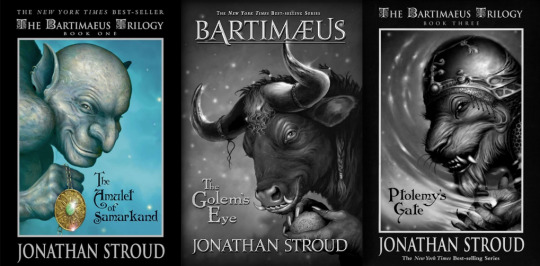
3 notes
·
View notes
Text

Architectural details of the temple of Quetzalcoatl in Teotihuacán, Mexico. :: [Robert Scott Horton]
* * * * *
“Quetzalcoatl, the Feathered Serpent, [...] came to teach [the ancient inhabitants of Mexico] the benefits of settled agriculture and the skills necessary to build temples. Although this deity is frequently depicted as a serpent, he is more often shown in human form--the serpent being his symbol and his alter ego--and is usually described as "a tall bearded white man" ... "a mysterious person ... a white man with a strong formation of body, broad forehead, large eyes and a flowing beard." Indeed, [...] the attributes and life history of Quetzalcoatl are so human that it is not improbable that he may have been an actual historical character ... the memory of whose benefactions lingered after his death, and whose personality was eventually deified. The same could very well be said of Oannes--and just like Oannes at the head of the Apkallu (likewise depicted as prominently bearded) it seems that Quetzalcoatl traveled with his own brotherhood of sages and magicians. We learn that they arrived in Mexico "from across the sea in a boat that moved by itself without paddles," and that Quetzalcoatl was regarded as having been "the founder of cities, the framer of laws and the teacher of the calendar.”
― Graham Hancock, Magicians of the Gods: The Forgotten Wisdom of Earth's Lost Civilization
#about art#Quetzalcoatl#mexico#Robert Scott Horton#Graham Hancock#Magicians of the Gods#the Feathered Serpent#ancient civilizations
10 notes
·
View notes
Text
Magic in BOTW: A Study of Elemental Weapons
Breath of the Wild is kind of vague when it comes to magic compared to other Zelda games. There’s no magic bar or characters that are mentioned to specialize in it, (aside from the dragons and maybe the champions). In fact, the magic that tends to be used the most seems to be from the Yiga. Sure, great fairy's and forest spirits like the koroks and blupees kind of have their own thing but I’m focusing on Hyrulians today.
Rods:
Though mostly used by Wizzrobes, according to their descriptions, the monsters did not create them. Fire/ Meteor Rods are described as being ‘crafted by an ancient magician’, Ice/ Blizzard Rods are ‘crafted from refined ice found at the summit of Hebra Peak’, and Lightning/ Thunderstorm Rods have a ‘gem [that] contains electricity from the Hyrule Hills’.
Hebra Peak is made up of special unclimbable ice that can also be found in the cavern that entombs the hebra great skeleton, this could be the refined ice that the ice rods are powered by. While ‘Hyrule Hills’ aren’t a specific place in the game, maybe that’s what Farosh Hills were called, as they’re also the hills that surround Lake Hylia which has several other similar names. (Lake Hylia, Hylia Island, Bridge of Hylia, Hylia River) Perhaps before Farosh showed up, the eastern hills had a similar name, But Hylia Hills sounded like a dirty joke so it was changed to Hyrule Hills.
Now, what about an ancient magician? One that’s only associated with fire magic... My immediate thoughts would be Twinrova or a magically inclined Goron (which is more likely but we’ll get to that a little later), in any case, their name has been long forgotten but who’s to say we haven’t met them before?
Also there’s definitely an aspect with using elemental powered gemstones for both the rods and the weapons. Each of their designs feature it at the end of their hilts and it just makes sense for the gemstones to either assist in the generation of elemental magic or the regulation thereof.
Flame Weapons:
Descriptions of the flame weapons describe that they were made in the fires/ lava/ magma of death mountain. This makes sense, this is not a new concept, I mean its the whole plot to the lord of the rings. but what really is interesting is when we get to the description of the great flameblade.

‘by Goron smiths in an ancient age’. Now that’s Lore! So there’s magic gorons. I’m thinking this is in the ten thousand years before botw/ golden age of Hyrule unless we can attribute this to existing characters. Maybe Darunia was really into making fire weapons or something. He was the Sage of Fire, that had to count for something.
Ice Weapons:
Like the Ice Rods, they were made with the ancient ice from the hebra mountains, though in the great flameblade version it ‘was forged by smelting ore found in the Hebra Mountains’ permafrost’ so that’s a thing. Hebra is mostly inhabited by Rito, who aren’t known to be very magically inclined, but there are also some Hylians. The area is generally pretty desolite with not a lot of evidence of civilization so it’s hard to tell who could’ve been behind the magic in that area. There’s the Zonai labyrinth and the entrance to the ice cavern looked vaguely Zonai or ancient Hylian in origin (like the ruins around the springs and the forgotten temple and Lanayru Promenade, like sksw era ruins)
Anyway the Ice is magic, but only the Hebra ice, not like the ice around the goddess spring or the ice around the actual ice dragon, no that ice isn’t magic. The random ass ice in hebra is the special magic ice. No, I don’t get it either.
Lightning Weapons:
Now here’s where it gets interesting. You’d expect that the magic from the electric weapons would come from the Faron region. WRONG. But that doesn’t matter. We’ll get to that.
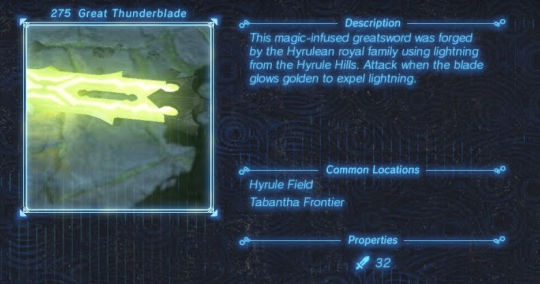
The Hyrulean Royal family is who is behind the thunder weapons. Which is odd, the royal family isn’t generally associated with weapons or lightning. or are they? One character comes to mind when I think of both Hylian royal family and lightning (and also making weapons), and that is Skyward Sword Link. So maybe the royal family could be linked to that but it still seems weird that they are the origin of them. Perhaps they had help from the sheikah, they had to do a whole lot of stuff with electricity just for Vah Naboris. Those metal orbs do remind me of the lightning enchanted metal...

This ball. the color is the same (but less bright) but still. Same vibes.
Lets get back to the Hyrule Hills thing. The thunderspear description clears this one up a little.
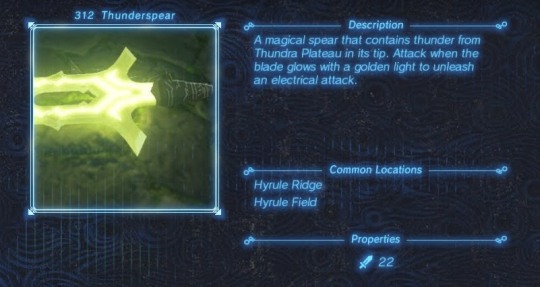
The lighting comes from Thundra Plateau, aka the place with the glowing balls and the eternal storm that I guess was going on for like ten thousand years, waiting for the shrine to be solved by the hero. This place is also heavily associated with the Zonai, as the ruins are the same as the ones around the spring of courage and in the dark shroud of Thyphlo.
Arrows:
The elemental arrowheads look different than the normal elemental metals. The only context that we get for them is that they are ‘imbued with the power of [insert element here]’ and while it would make sense that the arrowheads are just the same magical metals but cut up to be smaller but I would argue against it. There is probably a finite amount of elemental arrows and weapons that can have their metal harvested to make these arrows. Most vendors of these arrows claim to ‘find’ them rather than make them, and they also only tend to sell certain types rather than the entire roster. The arrow lady in Kakariko only sells fire arrows on top of their normal basic arrows, Rito Village and Hateno sell bomb arrows, etc. Only Tarrey Town and Gerudo Town sell packs of every type of arrows.
Anyway I’m absolutely convinced that the arrow lady in Gerudo Town is the creator of the elemental arrows. Gerudo Town is not new to enchantments, especially ones featuring gemstones, they’re also more associated with sorcery than the Rito kid who is the vendor in Tarrey Town.
I could talk more about magic in botw (the champions powers, the magic found in nature with gemstones and plants and animals, the sheikah and yiga abilities, magic in clothing, and also minor deities featured in botw, I will talk about these things if there is any demand or if I feel the inspiration to.) So this could be a series. So please tell me if you’d be interested in that because I would love to make more random in-depth analysis’.
#long post#i am not going to add a read more#botw#botw lore#breath of the wild#loz breath of the wild#legend of zelda#zelda lore#botw headcanons#botw analysis#video game analysis#I literally could not function until I finished this and now that it's over I have no idea what to do with myself
115 notes
·
View notes
Text
Build A Lesbian: Name Suggestions/Lore
We've done it! Our lesbian Salamander is done! Here she is in formal wear and a sketch of her work clothes. She's a copper smith (brownsmith) working with copper, tin, brass, and sometimes pewter. While iron was the undisputed king of "base" metals, most middle and upper class people's items for everyday use would have been made of brass and later pewter.

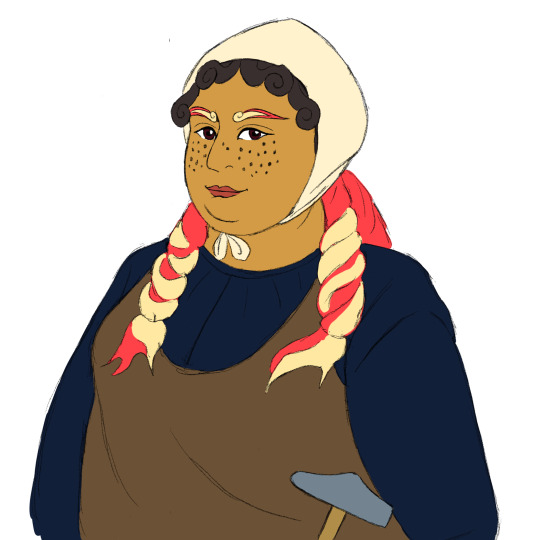
All she needs now are a name and a partner. Feel free to suggest names for her in the comments!
Potential names:
Brigid, Roxane, Barbara, Leoma, Glanis
Known Salamander names (alchemy, religion, influential literature)
Male: Oromasis, Apollyon, Helios, Mars, Vulcan, Proteus, Moroni, Djin, Porphyr, Phosphorus, Pyrhum, Aphtiph, Orudu, Itumo, Coroman, Tapheth, Oriman, Amtophul
Female: Amethysta, Fiammetta, Vesta, Serpentina, Aurora
The salamander was documented in the natural philosophy texts of Classical Greece and Rome. People believed it lived in fire, but attributed it to its body emitting such intense cold that it would extinguish the fire and allow the salamander to remain unharmed. The salamander was also believed to be highly poisonous, being able to poison an entire tree or well if it made contact. This gave the salamander a reputation as a popular magical familiar.
It was Paracelsus who introduced the concept of the Salamanders being the embodiment of fire. Paracelsus' Elementals, as described in his A Book on Nymphs, Sylphs, Pygmies, and Salamanders, and on the Other Spirits, are sentient beings with magical powers who lived within and embodied the four classical elements. However, they differ from humans in that they had no immortal soul which could enter Heaven, and only by marrying a human and receiving Christian sacraments could they have life after death. In a less religions and less Christian context, it simply means their bodies and souls return to their elements after death, both being dissipated to be used as building blocks for new elementals.
Paracelsus was also the first one to suggest they could shapeshift between human and beast forms. Salamanders live in hearths and volcanos. They would associate themselves with mankind to offer them kernels of wisdom or help them forge treasure, but unlike other elementals, rarely seek to marry humans for the sake of gaining entrance into Heaven.
Later Renaissance occultists, as elaborated in the Abbe de Villars' Comte de Gabalis (Count of the Kabbalists), add that because they live in the least material of elements, Salamanders are more chaste and morally upright than all other elementals. They are highly spiritual and possess powerful prophetic abilities. Modern occultists such as Manly P. Hall, Geoffrey Hodson, and the Order of the Golden Dawn state that of all the elementals, the Salamanders are closest to divinity.
Occultists sometimes interpret polytheistic gods, especially those associated with light or fire, as Salamanders. Abbe de Villars states that the Zoroastrian supreme deity, Oromasis (Ahura Mazda), was a Salamander, as were the Greek gods Apollyon (Apollo), Mars, Vulcan, and Proteus. Theosophists, New Age Spiritualists, and occultists also identify the Classical gods Vesta and Helios with fire and Salamanders. Anti-Mormon tracts posit the angel Moroni is a Salamander. Heinrich Heine suggests both God and the Devil, as they appear in German legends, should be Salamanders. Magic manuals give Tzabaoth (Lord of Armies) as the aspect of God they venerate, Michael as their archangel, Aral as their guardian angel, Seraph as the Angelic Order they're affiliated with, Samael and Oriens as their tormenting demons, and Djin as their king. Franz Bardon gives up to eight powerful Salamander nobles -- Pyrhum, Aphtiph, Orudu, Itumo, Coroman, Tapheth, Oriman, Amtophul -- that a magician can work with.
Like fire, Salamanders are passionate, but their tempers range from a raging inferno to a quiet smolder to an enlightened ray of wisdom. They rule the choleric temperament and its associated humor, making them active, quick-witted, and bold, but susceptible to being enslaved by their temper and passions. Abbe de Villars describes Oromasis as kind, forgiving, and charitable; while Apollyon is deeply pious and scandalized when St. Benedict destroys the sanctuary to Apollo and slanders its resident spirit as a devil. Aloysius Bertrand, in his Gaspard of the Night, includes one Salamander who delights in playing pranks on his incompetent wizard partner, as well as another Salamander who "dies of apathy", when he loses his only friend, a cricket. Another poet, Charles Mackay, shows his Salamandrine heroine Amethysta to be passionately loving, compassionate, and powerful and forgiving in turns, while her brother Porphyr is loyal but hot-tempered. Salamander-Moroni was also very wrathful, punched Joseph Smith in the head for not obeying his instructions in retrieving the Golden Plates. ETA Hoffman's Salamander Lindhorf was a wise archivist, but also temperamental and eccentric. Geoffrey Hodson describe a Salamander personally guiding him in a tour of a higher plane, while Marjorie T. Johnson collects fairy encounters where Salamanders are intense and fascinating. Traditionally, they tend to be skilled craftsmen or alchemists, as well as visionary poets or lawyers or even archivists.
As often noted, Salamanders do not often seek companionship with humans. Paracelsus and Manly P. Hall believe this is because they dread hurting humans with their fiery bodies, or that their mystic powers leave them susceptible to demonic possession. Abbe de Villars suggests they simply express more spiritual bonding than carnal desire. This didn't stop Charles Mackay from composing his The Salamandrine, where a knight falls in love with a Salamander, but then in true folklore fashion, abandons her for a rich noblewoman, and is cursed and branded with old age by her brother Porphyr. Nor did it stop the ballet Fiammetta, where a flame sprite is charged by Cupid to seduce a cynical nobleman. And there's always ETA Hoffman writing about a theology student marrying a Salamander and moving to Atlantis. Regardless, in my educated opinion as a folklore lover living in the modern age, Salamanders are simply asexual, in terms of physical attraction.
Salamanders in their humanoid forms possess a brilliant beauty, with intense, flashing eyes and glowing complexions. Their size varies, with Salamanders who manifest through big conflagrations being fiery-armored giants or dragons, to those emerging from little lamp fires being tiny mannikins or amphibians. Due to their homes being the most chaotic element, their bodies are long and lithe. Often they are described as having their head and bodies wreathed in flame. Their hair and skin tend to take on warm tones reminiscent of fire, with their hair being invulnerable to fire. They are identified with Ahura Mazda, radiant, glorious, and beautiful; Apollo, cloaked in gold with hair of gold and piercing eyes; and Moroni, with a face like lightning and white robes. Heinrich Heine gives them red courtier outfits. Hoffman's Salamander wore a robe of fire lilies. Anatole France clads his prospective salamanders in black smoke dresses.
Very few female Salamanders are mentioned in occult or folklore writings. They seem to almost all be male. As noted, this hasn't stopped some Romantic writers from imagining salamander brides, but otherwise Salamanders are always imagined as male. As a folklore lover living in the modern age, I propose that all Salamanders are born with biology that humans would identify as male, and female (or nonbinary) Salamanders transition into their preferred gender later in life.
#mythology#prompts#fantasy#fairy tale#folktale#folklore#salamander#elementals#fairies#build a lesbian#poll
4 notes
·
View notes
Text
Color Psychology in Tarot, part 1
Initial Comparison Between Two Decks
So as part of my personal musings on the relation between color and suit in RWS-based tarot decks, I decided to compare two of my own decks and show the pictures that resulted from them. These two decks are the Manga Tarot from Lo Scarabeo (written by Riccardo Minetti and illustrated by Anna Lazzarini) and the Celestial Tarot Cards from Kalan (and illustrated presumably by Canva because I've seen these clip arts in Canva before).
Notes: The Manga Tarot genderbends every single card in the deck and some Major Arcana cards are, thus, renamed (the Magician to the Sorceress, the High Priestess to the Priest, the Hanged Man to the Hanged Woman, and the Star to the Stars). The Celestial Tarot is a pip deck, and I mean that in the most intense way possible - every card is vaguely illustrated.
Example 1: Major Arcana - Death, the Devil, the Tower

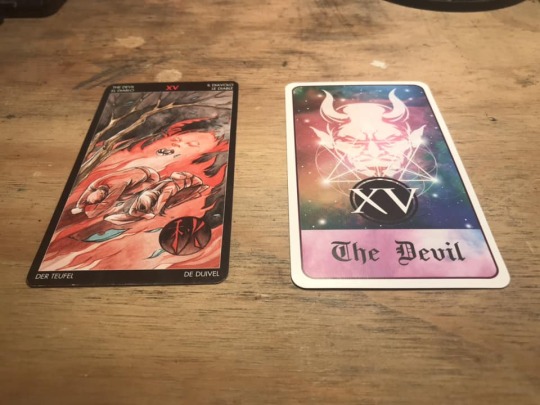
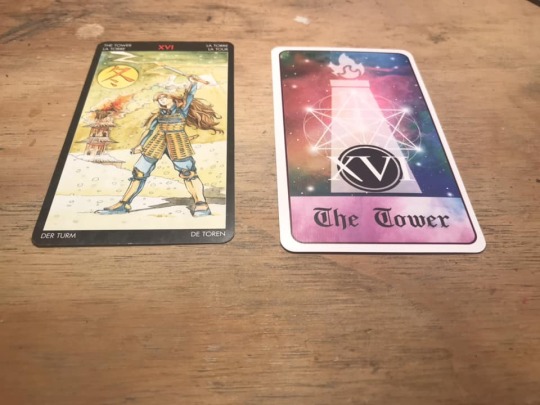
The biggest example of how color comparisons break down across these two decks is seen in the Major Arcana.
The Manga Tarot is dominated by a single color, though that color varies depending on the card. Death and the Devil are both red. The Tower and the Sun (not pictured) are both yellow. The Empress and the Hanged Woman (neither pictured) are both green. The Moon and the Hermit (neither pictured) are both blue. The Fool (not pictured) is grey to demonstrate how they're at the beginning of their journey and have a ways to go. The World has all of the colors to demonstrate the end of the journey and completion.
The Celestial Tarot (on the right in each image) has a multicolored rainbow background and then a transparent white overlay. This avoids attributing elements to the Major Arcana.
Example 2: Minor Arcana - 4 of Cups or Chalices, Queen of Pentacles, Ace of Swords, and 8 of Wands
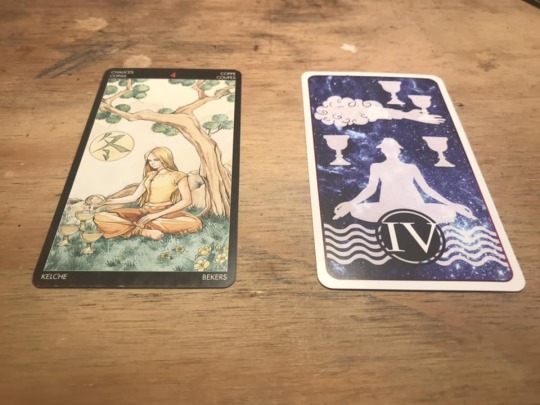

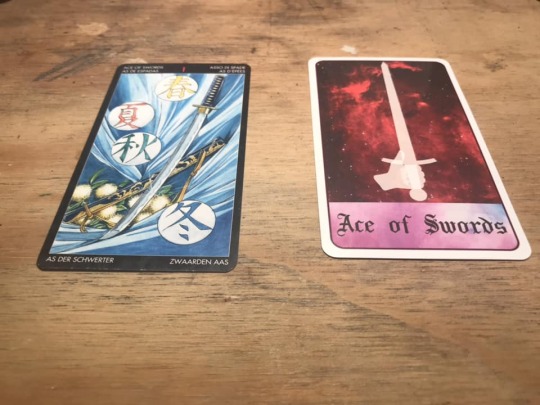
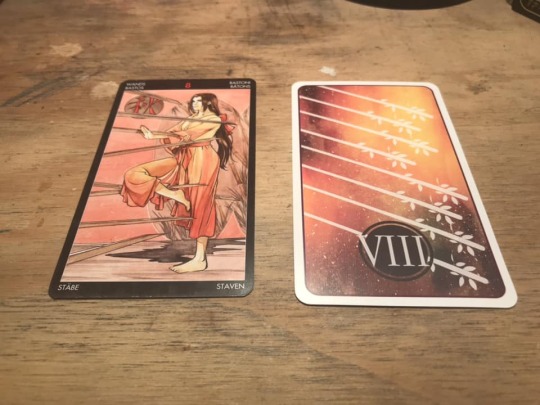
This is the best illustration of how the two decks approach the predominant color of their suits.
The Manga Tarot utilizes Western color psychology and matches them with suits in terms of personality. Yellow is associated with happiness, so it's tied to the Chalices, which rule emotions. Green is about money, abundance, and nature, so it's attached to the Pentacles suit, which rules the physical realm. Blue has connotations of intelligence and ties it to the intellectual Swords. And Red is about action and personality, tying it to Wands.
The Celestial Tarot Cards, on the other hand, tie the colors to the suits based on color. Blue is Water and Cups, Green is Earth and Pentacles, Red is Fire and Swords (according to some people), and Yellow is Air and Wands (again, according to some people).
Most tarot decks go with Swords = Air and Wands = Fire, but the Celestial Tarot Cards went a different direction and swapped the two. You're going to find all kinds of people who argue that this is how it's actually supposed to be, but we're not here about that detail.
In Conclusion
While most tarot decks either utilize color psychology in far more subtle ways or don't use it at all, these two decks are so overt in their usage of color that they make good examples for an introductory testing post.
If you'd like to see other posts like this that involve me getting really weird about these sorts of things, check out my Back to the Basics With Jasper directory.
#jasper post#tarot#tarotblr#elemental#colors#the jasper way#death#13 death#the devil#15 the devil#the tower#16 the tower#four of cups#queen of pentacles#ace of swords#eight of wands
12 notes
·
View notes
Text

vandalieu from yondome wa iya na shizokusei majutsushi (death attribute magician)
2 notes
·
View notes
Text

The top of an Elema Kundu drum represents the mouth of a crocodile the favorite animal of a magician. People don't get killed by crocodiles in this area, with all deaths by crocodiles are attributed to sorcerers' spirits who possess the crocodile and kill people.
3 notes
·
View notes